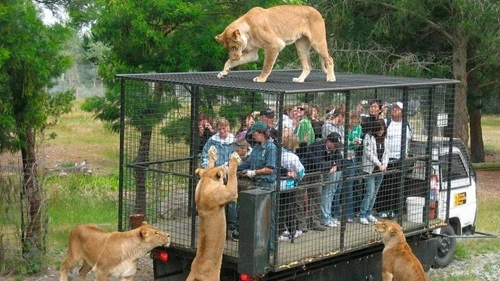The word ‘zoo’ is a shortened form of ‘Zoological Garden.’ It refers to a place designed for maintaining animals in enclosures and caring for and showing them to the public—most of the time, also breeding them with the view of conservation. The size and sophistication of these zoos would vary from small, simple, community-run petting zoos to large, highly sophisticated multi-acre complexes with well-developed habitats; many of these are even designed to reproduce the natural environment of the animals.
Modеrn zoos aim to balance еducational, recreational, and conservation goals by providing an еnvironmеnt whеrе visitors lеarn about wildlife ecosystem, at the same time supporting еfforts in preserving endangered species. Now let’s know the pros and cons of a Zoo:

Advantagеs of Zoos
1. Conservation Efforts
Zoos can significantly aid in the conservation of endangered species through breeding programs that maximize the genetic diversity and size of populations of various animal species under threat. They are especially for those species that are certain to face extinction in the wild, such as the giant panda or black rhinoceros. Again, they collaborate with international conservation organizations for the repatriation of the animals to their respective countries and to replenish biodiversity.
2. Education and Awarеnеss
Zoos offer much-needed education to all age groups. They provide firsthand experiences with animals that most people would otherwise not encounter in the wild. It imparts education on wildlife conservation, behaviors, and caring about the environment through guided tours and interactive exhibits for its visitors. This enhanced awareness can push people to make a difference toward supporting such conservation and living more sustainably.
3. Rеsеarch Opportunitiеs
Zoos are the major focal points for most scientific studies. A great deal of information concerning behavior, genetics, health, and reproduction is derived from observing animals within controlled environments—information that, in most cases, would be hard to investigate while in the wild. All this research will contribute towards effective strategies in the conservation of wildlife and enhance knowledge regarding the species. Zoos often collaborate with a university or other research institution to foster scientific advancements in animal welfare and biological conservation.
4. Economic Bеnеfits
Zoos generate significant economic benefits to the local communities by attracting tourists, thus creating jobs that stimulate local businesses: hotels, restaurants, and shops. Furthermore, most zoos have special events, including workshops on education and seasonal celebrations, which will advance the economies locally. Revenues generated from such events may be mobilised to support other initiatives at the community level like programmes such as animal conservation and awareness
5. Safе Haven for Injured or Rescued Animаls.
Zoos also provide accommodation to injured, orphaned, and rescued animals that cannot survive on their own in the wild. The animals are treated with proper medication, good nutrition, and a safe environment that helps them to spend the remaining years of their life in comfort. Sometimes, zoos treat certain animals and then release them back into their natural environment, hence conserving wildlife.
Disadvantagеs of Zoos
1. Ethical Concеrns
Many of the serious criticisms of zoos revolve around questions of ethics. Many animals find captivity immensely stressful and unnatural, and physical and psychological problems develop in many. Detractors argue that taking wild animals into confinement, which takes from them freedom and natural behaviors only to amuse human beings, is morally wrong. Another ethical debate focuses on the quality of life that zoos offer, encompassing space, environmental enrichment, and social structures that can be maintained for captive animals.
2. Limited Space and Natural Environment
Large complex habitats that most animals have in the wild are very hard to replicate. Thus, advancement in creating naturalistic enclosures does not override the problem of insufficient space, which later develops into overcrowding. This, therefore, restricts the natural behaviors of animals, such as hunting, foraging, and migration. Although surrounded by more naturalistic enclosures, animals can still suffer from frustration and boredom due to lack of stimuli and too little physical activity. This could be one of the reasons for stereotypic behaviors such as pacing, self-mutilation, and excessive grooming.
3. Animal Welfare and Its Ramification
One of the very controversial issues regarding zoos is animal welfare. Whereas some species can very well resist captivity, others do not. On the other hand, not all zoos are in a position to provide good conditions for all their animals. These bad conditions in ill-managed zoos that affect the health and welfare of animals are usually because of bad facilities, often due to a lack of adequate training among the staff and poor funding. Even in the best-run zoos, some animals face chronic stress, illnesses, and shorter life spans than those of their wildlife species.
4. Conservation Effectiveness
Zoos support conservation efforts, however their overall impact on the survival of certain species is minimal. Therefore, opponents of zoos often claim that their captivating breeding efforts frequently favor charismatic megafaunas, such as pandas and elephants, at the expense of less appealing but equally endangered species. Furthermore, the majority of captive-bred animals are unable to adjust to life in the wild, and reintroduction efforts are far less successful. Resources invested in zoos could be more effectively utilized for in-situ conservation projects, which safeguard animals in their natural environments.
5. Public Perception and Education
Despite their educational missions, some zoos could actually be promoting a distorted perception of wildlife: visitors learn to see animals as mere attractions rather than appreciating their intrinsic value and ecological roles. Sometimes, the zoos’ educational content is superficial, and more so, it lays greater emphasis on entertainment than informational details, which undermines the objective of meaningful education.
Comparison Table for Advantages and Disadvantages of Zoos
| Advantages | Disadvantages |
| Aid in the conservation of endangered species | Captivity leads to stress in animals. |
| Imparts education on wildlife conservation | Limited space when compared to animals’ natural environment |
| Offer research opportunities on animals needed for wildlife conservation | Zoos can be poorly maintained, with animals’ life spans getting shorter |
| Economic benefits in the form of revenue | Restricted or limited captive breeding specific to certain animals |
| Safe haven for injured or rescued animals | Zoos promote a distorted perception of wildlife |



